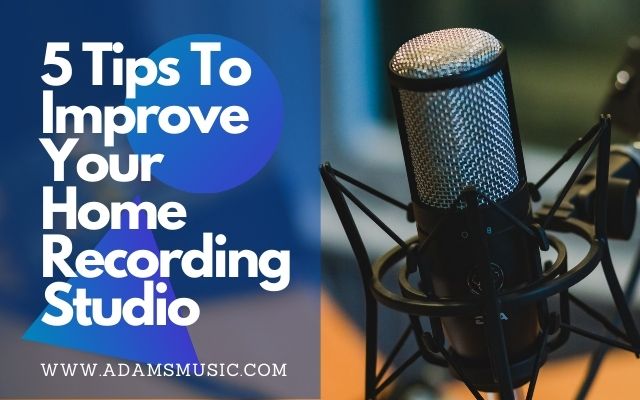Setting up a studio for home recording can be challenging. Big budget studios are built from the ground up, have thousands of dollars in sound treatment, and an array of vintage and modern equipment. Most people don’t even have the luxury of dedicating a full room to be a home studio. When you’re in a small space with limited equipment, you have a lot working against you. Here are a few ways to improve your home recordings, and make your music sound more professional.
Set Up In The Correct Space
Finding a good space to set up your studio can save a lot of time and frustration in the long run. Whenever possible, try to set up in a small room with a carpeted floor. A bedroom is a good option because the bed is great at absorbing sound. Anything else that breaks up sound reflecting off the walls is helpful. Cloth furniture, bookshelves, and plants provide a lot more sound deadening than you’d think. Try to avoid setting up in a large, empty room with hardwood floors.
Reduce Ambient Noise
One of the cardinal rules of audio engineering is you get out what you put in. If you’re in a noisy room, you’re going to have a muddy recording that won’t sit well in any mix. The first thing you should do is is turn off any fans, TVs, or anything else that’s making background noise. It’s also a good idea to put your phone on silent. Even on vibrate, notifications can ruin a good take. Your microphone is very sensitive. It’ll pick up faint vibrations from people moving around or tapping their feet. A phone vibrating in the middle of a song will sound like an earthquake.
Speaker and Microphone Placement
Whenever possible, you should move your monitors away from the corners of the room. This will help reduce bass buildup that will make your mixes sound muddy. Also, try to position your microphone away from any surfaces that might reflect sound. If the combination of audio input and reflected sound is off, your recording will be out of phase. Consider buying a pop filter for your microphone as well. This acts as a windscreen and will block plosives and breathing sounds.
Adjust Your DAW Settings
Although many people still use analog equipment, a digital audio workstation (DAW) is an essential part of any home recording studio. The first thing you should do when setting up your DAW is to adjust the bit rate and sample rate. By default, it will be set to 16-bit and 44.1kHz, which is good if your computer isn’t very powerful. Setting the rates higher can create under-runs and digital artifacts. If possible, have your bit rate set to 24-bit and a sample rate of at least 96kHz. This will give you the best audio quality without filling your hard drive with huge audio files.
Practice With What You Have
The best skill a home musician or engineer can have is the ability to make something out of nothing. The longer you use your setup, the better you’ll get at utilizing the equipment and space you have available. Then, when you can afford a nice piece of equipment, you’ll be able to effortlessly incorporate it into your setup and use it to its fullest potential. You can make a hit record with nothing but a USB microphone and a laptop. Learning how to use your tools properly will get you further than fancy equipment.
Looking For Home Recording Equipment and Instruments?
Adam’s Music is your friendly neighborhood music shop in West Los Angeles. We have a wide variety of instruments and musical equipment for sale or rent. We also offer a free, half-hour introductory music lesson over video chat. If you’ve always wanted to pick up a new instrument or brush up on your technique, now’s a perfect time! Contact us today to arrange a free online music lesson with one of our teachers.





